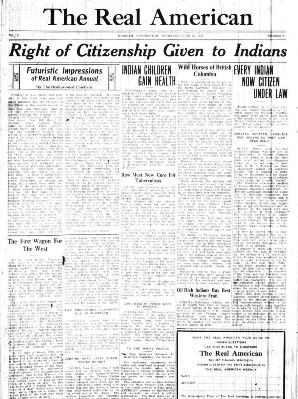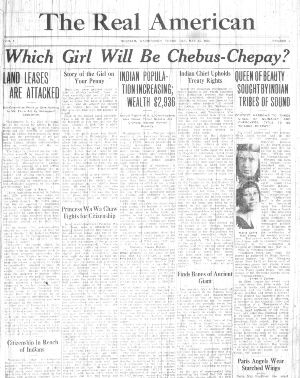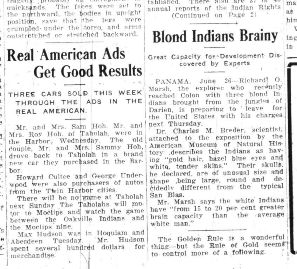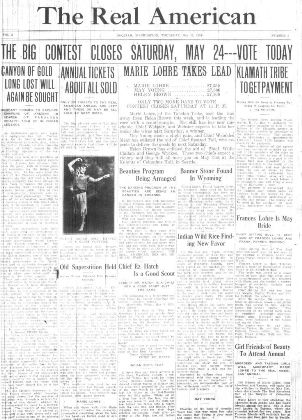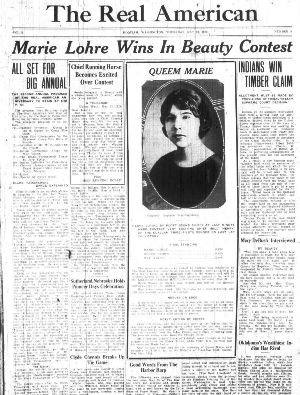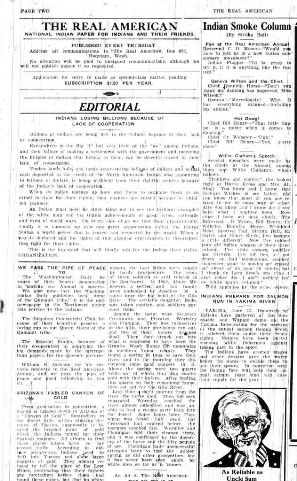The Real American was a weekly paper by published by Hugh Howell in the small coastal town of Hoquiam, Washington. Published between 1922 and 1924(?), the stated purpose of the paper was to serve as a “National paper for Indians and their Friends.” The pages of the newspaper carried a wide-range of content, including news about local cultural events, the national struggle of Native Americans, and numerous advertisements. Little is known about Hugh Howell, the editor, but articles from the newspaper suggest he was a member of a local tribe, as were the rest of the four members of the editorial staff. Erin Plummer’s paper argues The Real American advanced a pan-Indian agenda, by connecting and informing local Indians in Western Washington with national news about native struggle. In addition to this political content, throughout the 1924 editions, the paper focused heavily on local cultural events, particularly a local beauty contest. Some of these articles have been included on this page.
- Dates: 1922-1924
- Circulation: Unknown
- Price: $1.50 / year
- Editor: Hugh Howell
- Address: “The Real American,” Box 692, Hoquiam, Washington.
- Location of Research Collection: University of Washington, Suzzallo Library, Microforms and Newspaper Collection, A8550
- Status of Collection: The library carries an incomplete run of the paper, v.3 no.3-13 (May 15, 1924-July 17, 1924).
Editions of the Real American newspaper published from May to July, 1924 chronicle many of the issues facing the Native American community of Washington, as well as the Native American communities around the United States during the early 20th century. Published in Hoquiam, Washington, the Real American primarily served as a news source for the Native Americans of the Northwest, yet on several occasions, articles appeared about the Native American community in the Southwest and other parts of the United States. The newspaper sympathetically described the struggles of Native Americans and gave light to the idea of a Native American community that transcended tribal barriers. The name of the newspaper, Real American, gives the sense that writers and intended readers of the newspaper felt they were the only people who could truly be called Americans. Even if others took this title, it only rightfully belonged to them. Through its use of sympathetic articles and its discussion of American authenticity, the _Real American_newspaper promoted solidarity among all Native groups and encouraged the construction of a community based upon common indigenous heritage.
Each issue of the Real American from May to July of 1924 featured sections for each of the sub-communities of the Hoquiam area. These sections provided a way for the individuals in each particular community to make announcements. For example, in the May 22, 1924 issue, the first line of the section entitled “Aberdeen News” read, “The stork was a recent visitor to the Chenois family, leaving a lusty ten-pound papoose.”1 This clearly illustrates the newspaper’s desire to bring together the Native American community of Washington State. Announcements like these also gave the community a chance to take a break from the harsh realities that were occurring all around them—political issues, etc.—and share the excitement and joy felt by their fellow community members. By facilitating the publication of news from each sub-community, the Real American gave its readers and community members the feeling they were part of a larger community.
Similarly, this sense of community extended well beyond the boundaries of Washington State. An article in the May 15 issue about the Navajo sympathetically described the tribe’s battle with the government over their right to perform medicine dances. In the article, the author writes, “There is mourning on the Navajo Reservation in Arizona; for the Great White Father in Washington has frowned upon medicine dances.”2 Underscoring the importance of the issue, this article was featured on the cover of the paper and filled the entire page. Although the Navajo were hundreds of miles away from the Hoquiam area, by highlighting such an article in the Real American, the editor hoped to bridge the gap between Native Americans of different tribes and different geographical locations. Articles like this one gave readers an opportunity to share stories with tribes from far away places and feel a connection with the peoples of those places who were undergoing these struggles.
The article about the Navajo not only shows the newspaper’s effort to help form a Native American community by bridging gaps between tribes, it also demonstrates efforts to preserve Native American customs. In the Navajo article, the newspaper described one tribe’s fight to maintain their traditional methods of healing. Another article in the May 22 issue of the Real American talked about the extinction of the Indian tepee style of housing. The article argued that Native Americans were becoming more and more likely to live in the ‘white man’s house’ than the traditional Native American wigwam. The newspaper chose to include these struggles in the news it reported in order to bring the community together and create a sense of urgency in protecting their Native American heritage.
From the colonial days until the present time, the Indian population has fluctuated. Many Native American communities were completely wiped out while others maintained some population. The Pueblo Indians in New Mexico were just one of the many tribes that struggled to keep their tribe alive. The Real American chronicled the struggles of the Pueblo tribe: “Members of the oldest civilization extant in America are now battling for life against a combination of desperate odds.”3 This article detailed the dangers facing the Pueblos, namely the ongoing efforts of white settlers to seize tribal lands and threat of disease. The _Real American_may have intended to warn its readers that they too could face struggles similar to those of tribes like the Pueblos. Articles about population numbers were not always so depressing. Although several tribes lived under threat of encroachment and disease, the overall population of Indians in the United States was steadily increasing in the 1920s. The May 15, 1924 issue covered the growing number of Native Americans in the United States and also the growing number of Native American children in school. These articles were meant to inspire hope in Native American communities. Native Americans as a whole were keeping their population alive and this inspired the individual communities to continue fighting for the protection of their communities and traditions. Documenting the success of Indian communities, the Real American continued to promote the idea of one Native American community and inspired more to join.
Not only did Native Americans have to fight to keep their people alive, they also had to fight to keep the land that had belonged to them for hundreds of years. Throughout the 1920s, native communities were engaged in a number of land battles throughout the country. The May 29 issue of the Real American featured an article about a timber claim that had been won by the Quinault Indians of Washington State. The June 19 issue included an article about the same claim, reporting that the allotment of these lands would be deferred to a later date. Land battles like the Quinault case were very common during this period. The Real American presented these articles in a way that would create a sense of hope in the reader. At the same time, the paper made it obvious the battles would not be easily won and encouraged Native Americans to stand up and fight for what was rightfully theirs.
The Real American also featured updated news about land battles that were occurring in other parts of the country. The June 5 issue detailed the issues surrounding an ongoing law suit in Texas, in which Indians were suing to control more than one million acres of land in the Panhandle. The paper informed its readers that the Texas Cherokee based their claim upon a one-hundred year old treaty, which had been signed by their ancestors and the Republic of Texas. It was common for treaties between whites and Natives to be manipulated in favor of the whites and this article gave hope that the Indians would be able to renew their claim. Coverage of treaty rights provided one more example of how the Real American contributed to the creation of a broadly defined Native American community. In pointing out similarities among native peoples all over the United States, the newspaper attempted to convince its readers to set aside their tribal differences and come together as one people.
The Real American also recognized the important role of education for an emerging nationwide indigenous community. Articles about population growth also provided information about the growing number of pupils attending the Indian schools. The tone of these articles are optimistic in that they realize the importance of education, but they also realize that funds for the schools were far short of what they needed to be. The May 15 issue addressed this concern and in a subtle way encouraged the community to stand up and fight for the funding that was necessary.
The newspaper also set out to correct some common misconceptions among the white population about Native Americans. The June 12 issue carried an article entitled “To the White People,” which read:
The conflicting statements, half-truths and prejudiced personal views flooding the country today in the discussion of Indian questions, make it exceedingly difficult for the average person to form accurate conclusions.
The editorials and articles dealing with the Past, Present, and Future of the Indian printed in THE REAL AMERICAN possess an individuality and character not found in other publications. The Real American is edited and published by all Indians who are up to the minute in all questions regarding the Indian.4
This shows the Real American was not only out to create a community of Native American people but it also wanted to educate white people interested in hearing both sides of the conflict between white Americans and Native Americans.
The Real American promoted the formation of a Native American community in many ways. The newspaper presented articles about several different tribes to promote their belief that Native American people were all one people - a people that needed to stick together in order to overcome the challenges that faced them. The newspaper also presented several ideas about what it meant to this particular community to be American and in this case be a “real” American. The Real American did not equate being American with United States citizenship. Rather, the newspaper considered its readers and the communities it served to be ‘real’ Americans. Before the expansion of citizenship rights to all Indian people in 1924, in all its issues the newspaper implicitly refused to recognize the institutions and politics of the United States as authentically “American.” Only when native people were granted full citizenship rights under the Snyder Citizenship Act, did the newspaper redefine the meaning of “American” to include the United States.
The June 12th issue featured an article with the bold and large headline: “EVERY INDIAN NOW CITIZEN UNDER LAW.”5 Despite its prominent placement, the article was extremely short. It was only a few sentences long and briefly mentioned the act that was signed into law by President Coolidge making every native born Indian a citizen. The brevity of the article suggests the editors of the paper did not necessarily equate citizenship rights from the United States with Indians’ “American” authenticity. The Real American had consistently referred to the Native American communities that were its audience as the only true Americans even before the law had passed.
Although citizenship was not the most important qualification to be considered “American,” the newspaper immediately recognized how it could be a helpful tool when fighting for equal rights. In the July 11 issue of the Real American, an article entitled “Miss Williams Makes Protest to President” published a letter written to the president of the United States. Borrowing language from the Declaration of Independence, the letter’s author pointed out that “as free born Americans,” Indians should be guaranteed the “right to life, liberty, and the pursuit of happiness” and have the right to practice their religious beliefs.6 With their citizenship secured, the publication of this letter suggests Native Americans were willing to stand up to the president and ask for the rights promised to every American citizen. Though Native Americans always saw themselves as Americans, being granted citizenship was a useful tool in the struggle for equal rights. The government had accepted the Native Americans as citizens, and by doing so, Native Americans felt justified in exercising their political rights. They had been standing up for their rights and fought for equal treatment for many years, but now they had the law on their side.
Issues of the Real American also made several other references to role of the Native American in American institutions. An article for the July 3 issue, entitled “Symbolism,” highlighted the Camp Fire Girls’ use of Native American symbols. This article spoke with pride that the Camp Fire Girls would use Indian symbolism. As the author suggested, “Indians are Americans” and “Camp Fire is essentially an American movement.” The article further argued the club for girls was helpful to the Indian cause: “Symbolism in Camp Fire gives color and interest to our living… thereby enriching life.”7 As a positive integration of Native American culture into American culture, the article brought a sense of pride to the readers of the Real American. Although Native Americans had always seen themselves as the authentic American, the appropriation of native symbols suggests white Americans were beginning to see this too.
The Real American newspaper from Hoquiam, Washington promoted the idea of a broad and solidified Native American community in many ways. The newspaper introduced Native Americans in the northwest to the struggles of other tribes living in the United States. The newspaper also brought together diverse native communities by allowing its readers to share in the triumph and travail of other tribal groups. The Real American brought together Native Americans as a community, setting aside tribal differences. The newspaper defined what it meant to be American in many ways and gave its readers a sense of pride in having such an identity.
© Erin Plummer 2005
HSTAA 353 Spring 2005
1 Real American, May 22, 1924.
2 Real American, May 15, 1924.
3 Real American, June 5, 1924.
4 Real American, June 12, 1924.
5 Real American, June 12, 1924.
6 Real American, July 11, 1924.
7 Real American, July 3, 1924.

